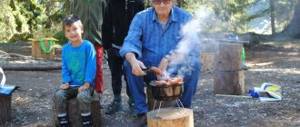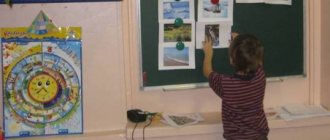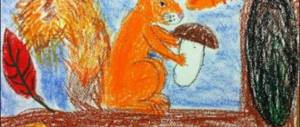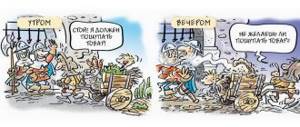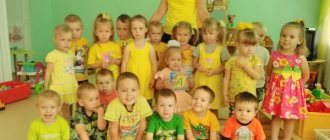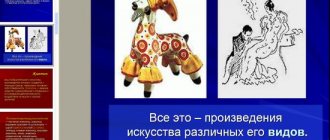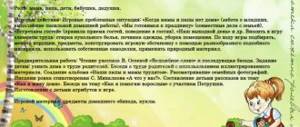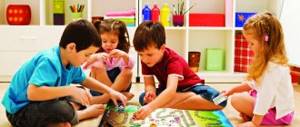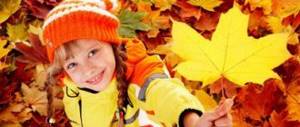FOOD CHAINS IN THE FOREST
| Vladimirova Alena Pavlovna additional education teacher |
Topic: “Food chains in the forest”
for preschool children
Target:
Expand children's horizons about the life of forest animals. Objectives: Educational: - To form basic ideas about the relationships between forest inhabitants: plants and animals, their food dependence on each other. Developmental: - Develop the ability to create ecological chains and give reasons for your actions. — Stimulate children's cognitive interest. Educational: - Cultivate good feelings towards peers and yourself. — Foster a caring attitude towards nature. Materials and equipment :
- computer presentation,
— “Food chain” model
- handouts (pictures of animals, glue, cardboard),
Progress of the lesson
I. _ Organizing time
II . Learning new material
1. Guys, listen to the riddle: This city is not easy, but dense and dense. (Forest) Today in class I want to talk to you about the forest.
What do you think a forest is?
Children's answers......
The forest is a special, beautiful world that consists of many trees, herbs, shrubs and animals. What kind of trees do you think grow in the forest?
Children's answers......
But today we will talk to you about a forest in which these trees grow:
1.What kind of tree is it?
There is no wind, but everything is trembling? (Aspen)
2. Sticky buds, green leaves.
With white bark stands under the mountain. (Birch)
Repeat what trees we just named
2.Animals of the forest
Guys, now I want to tell you riddles about forest dwellers, about those who live in the forest.
- You and I will recognize the animal
According to two such signs:
He's wearing a fur coat in the gray winter,
- And in a red fur coat - in the summer. (Squirrel)
Cunning cheat
red head,
The fluffy tail is beautiful!
What is her name? (Fox)
- A ball of fluff, a long ear,
Jumps deftly, loves carrots (Hare)
- Steals crumbs
- Afraid of cat (Mouse)
- Hairy, green
She hides in the leaves
Even though there are many legs
Still can't run (Caterpillar)
- Knocking all the time, hitting trees
But he doesn't hurt them,
He only heals them (woodpecker)
Well done, you solved all the riddles. Look carefully, can all forest dwellers live in a forest where trees such as birch and aspen grow?
Children's answers…..(children exclude the squirrel)
III . Physical education presentation - Now let’s take a little rest. We will walk along a mysterious road. Mysterious legs walked, how did they walk? (bear, fox, squirrel, hare) answer Do exercises based on the text.
3. Food chains
The forest is a home for animals, in which they not only live, but also feed. To live, living things need to eat.
IV . Group work
You are divided into three teams. Each team will be given a task.
Now you need to glue on a piece of paper what animals eat and what?
Aspen hare fox squirrel
Aspen caterpillar woodpecker fox squirrel
Grass mouse fox squirrel
4. Consolidation of the studied material
Now we will check how correctly you completed the task!
— The first team comes out
— The second team comes out
— The third team comes out
Guys, you have now worked in groups, each team has created chains. In another way it is called “Food Chain”
Children, look at the food chain in the forest.
- The sun is warming, the aspen is growing, the hare is eating the aspen, the fox is eating the hare
- The sun is warming, the aspen is growing, the caterpillar is eating the aspen, the woodpecker is eating the caterpillar, the fox is eating the woodpecker
- The sun is shining, the grass is growing, the mouse is eating the grass, the fox is eating the mouse
Everything in the forest is interconnected, everything depends on each other.
And the dependence in the forest on each other is called the “Food Chain”
5. Summary of the lesson. Reflection
– What do you remember?
– What new did you learn?
– What was the most interesting?
Bibliography:
- Ryzhova N.A. Environmental education in kindergarten. – M.: Publishing house. House "Karapuz", 2001.
- Bondarenko T.M. Environmental activities with children 5-6 years old: A practical guide for educators and methodologists of preschool educational institutions. – Voronezh: TC “Teacher”, 2002.
- Voronkevich O.A. “Welcome to Ecology” is a modern technology for environmental education for preschoolers. // preschool pedagogy. 2006 No. 3, p. 23.
- Solomennikova O. Diagnosis of environmental knowledge of preschoolers. // Preschool education. 2004. No. 7, p. 21.
- Program “Curious” (world of plants, world of animals). – Samara, 1992.
- How to introduce preschoolers to nature. /Ed. P.G. Samorukova. – M.: Education, 1978.
Application
Food chains
Goal: To develop in children an idea of the relationship between the inhabitants of the forest - plants and animals, and their food dependence.
Progress of the lesson.
Educator: Due to the fact that 2020 has been declared the Year of Ecology, the Community of Young Ecologists of our city sent us this wonderful book on April 15 (Ecological Knowledge Day) and invites us to join the ranks of young ecologists.
slide
(Q: What month is it now? Time of year?…..) There is time until April, but in order to join the ranks of Young Ecologists, you need to show your knowledge.
Q: open our book
Advertising message
-who is this? (animals), which ones? (wild), how can they be divided according to the method of feeding? (predators and herbivores, list them).
Pay attention to the bear: is it really a predator? After all, he has a sweet tooth and loves to eat berries, honey, and roots? (a bear is a predator, because it eats small animals that it can catch and can attack humans).
The wolf is definitely a predator!
Slide
What does a wolf like to eat? (hare)
Do you think there should be more hares in nature than wolves, or equally, so that there is enough for everyone? (there should be more hares in nature, because some of the hares should give birth)
If we take a rectangle, which one will be larger, the one that represents wolves or hares? (hares)
Slide
Q: But hares do not exist on their own, they also need to eat, what? (grass)
How much grass should there be in nature? (a lot, because grass is food for animals, a home for insects, humus for the forest)
If we denote hares and grass by a rectangle, which one is larger? (the one that denotes grass)
Slide
Q: This is how the structure turned out, what does it look like? (children's assumptions)
Is it possible to make it even bigger? What can you add? (earth, water, sun...).
What geometric figure does it resemble? (triangle, pyramid) - in biology this is called an ecological pyramid.
Slide
Game: build an ecological pyramid!
The teacher divides the children into teams of three. Each team receives 3 cards with printed words, for example: lynx, grass, antelope. The teacher invites the children of one team to read, confer and line up in an ecological pyramid, starting with the predator.
2nd team: leaf, caterpillar, bird
3rd team: grass, ladybug, aphid
4th team: acorns, mice, fox
etc
Q: Everything in nature is interconnected, all inhabitants - plants and animals - depend on each other.
Is it possible to remove a participant from the ecological pyramid from nature?
Slide
Q: Let’s imagine that the hares have disappeared! (children's answers) –
the wolf and other predators have nothing to eat and they will begin to die out.
Slide
Q: Let’s imagine that the wolf is gone! (children's answers)
-at first the hares will feel good, there will be a lot of them, but then there will be little grass, they will start to get sick and die out.
Q: Who can help nature maintain balance? (Human)
What does a person do to preserve the number of animals? (reserves, sanctuaries, the Red Book, zoologists monitor the number of animals in nature, ecologists help in the construction of wastewater treatment plants….)
How can you and I help in protecting nature? (do not light fires, do not throw garbage in the forest, do not kill insects, feed birds, do not fish with electric fishing rods)
Productive activity: choose the animals yourself and build an ecological pyramid (application).
Partner promotions
Didactic games on ecology.
Guess what's in your hand?
Children stand lined up in a circle, holding their hands behind their backs. The teacher places fruit models in the children's hands. Then he shows one of the fruits. Then he shows one of the fruits. Children who have identified the same fruit in themselves run up to the teacher at a signal. You cannot look at what is in your hand; you need to recognize the object by touch.
Flower shop
Target:
consolidate the ability to distinguish colors, name them quickly, find the right flower among others. Teach children to group plants by color and make beautiful bouquets.
Progress of the game:
Children come to the store, where there is a large selection of flowers.
Option 1.
On the table is a tray with colorful petals of different shapes. Children choose the petals they like, name their color and find a flower that matches the selected petals in both color and shape.
Option 2.
Children are divided into sellers and buyers. The buyer must describe the flower he has chosen in such a way that the seller can immediately guess what kind of flower he is talking about.
Option 3.
Children independently make three bouquets of flowers: spring, summer, autumn. You can use poems about flowers.
Distribution of fruits by color
The teacher invites the children to distribute the fruits by color: put fruits with a red tint on one dish, yellow ones on another, and green ones on a third. The game character (for example, Winnie the Pooh) also participates in this and makes mistakes: for example, he puts a yellow pear with green fruits. The teacher and children kindly and delicately point out the teddy bear’s mistake and name shades of color: light green (cabbage), bright red (tomato), etc.
Distribution of fruits by shape and taste
The teacher invites the children to arrange the fruits differently, according to their shape: round - on one dish, oblong - on another. After clarification, he gives the children the third task: distribute the fruits according to taste - put sweet fruits on one dish, savory ones on another. Winnie the Pooh is happy - he loves everything sweet. When the distribution is over, he puts the dish with sweet fruits next to him: “I really love honey and everything sweet!” “Winnie the Pooh, is it really good to take all the delicious things for yourself? - says the teacher. – Children also love sweet fruits and vegetables. Go wash your hands, and I’ll cut the fruits and vegetables and treat everyone.”
Root tops
Children sit in a circle. The teacher names vegetables, the children make movements with their hands: if a vegetable grows on the ground, in a garden bed, the children raise their hands up. If the vegetable grows on the ground, the hands are lowered down.
Find out and name
The teacher takes plants from the basket and shows them to the children. Clarifies the rules of the game: here are the medicinal plants. I will show you some plant, and you must tell me everything you know about it. Name the place where it grows (swamp, meadow, ravine) And our guest, Little Red Riding Hood, will play and listen about medicinal herbs with us. For example, chamomile (flowers) is collected in the summer, plantain (only leaves without stems are collected) in the spring and early summer, nettle in the spring, when it is just growing (2-3 children’s stories)
Outdoor game “Food chains”
PPDO, 2 course, ozo
Test : test based on lectures and independently studied material.
Test: completion of the proposed tasks below + their demonstration in practical work during the summer session.
1. Get acquainted with the material of lecture No. 1 by N.A. Ryzhova “Content of environmental education for preschool children” , No. 2 “Environmental education: changing stereotypes” . Make short lecture notes.
2.History of the development of environmental education for preschool children
Fill out the table based on the materials in Appendix No. 1.
| Teacher | Basic pedagogical ideas in the field of EE | Nature awareness program | Methods/Forms | Basic pedagogical works | Connection with modernity |
| Ushinsky K.D. | |||||
| Vodovozova E.N. | |||||
| Tikheyeva E.I. | |||||
| Shleger L.K. |
3. Ecological and developmental environment of preschool educational institutions
· Get acquainted with the material of lecture No. 4 by N.A. Ryzhova “Developmental environment for environmental education: environmental complexes in preschool educational institutions” (for those who were not at the lesson on November 17, 2017)
· After reading the lecture material, complete the task:
Select plants and animals for corners of different age groups with justification for your choice; create a directory folder with information ( information that should be on plants: morphology, origin and analysis of growing conditions in the natural environment, methods of reproduction, methods of daily and periodic care for them; on animals: appearance, lifestyle, methods of feeding and movement , care of offspring; conditions of detention in a corner of nature
).
Possible options:
A) Living objects of a corner of nature in the younger group (2 sections: animals and plants).
B) Living objects of a corner of nature for children of middle preschool age (2 sections: animals and plants).
C) Living objects of a corner of nature for children of senior preschool age (2 sections: animals and plants).
!! The first page should contain explanations about the features of the selection of plants and animals.
4. Get acquainted with the basic principles that need to be taken into account when choosing methods and forms of work on environmental education for preschool children . Ryzhova N.A., lecture No. 7 “Methods of environmental education for preschool children,” p. 41-48
5. Observations
A) Make 3 detailed notes of observations during a walk: 1. of an object/phenomenon of inanimate nature, 2. of an animal, 3. of a plant (indicating: name, program content/goals and objectives, progress of observation)
For example: watching the rain, watching the sun, watching the wind, watching the sparrows, watching the icicle, watching the leaves fall, watching the maple, watching the butterflies.
For an example of recording observations, see Serebryakova p. 174-180
B) Come up with a series of observations of the turtle/snail Achatina/canary.
Modeling
Each person should create three models: a subject model, a subject-schematic model, and a graphic model – for demonstration during practical classes during the summer session.
Take examples of models from the textbook by E.V. Goncharova, distribute themselves within the group so that each model is made and presented in class.
Link to tutorial:
https://nvsu.ru/ru/Intellekt/1130/Goncharova%20E.V.%20Teoriya%20i%20metodika%20ekologicheskogo%20obrazovaniya%20-%20Kurs%20lektsiy%20-%202008.pdf
Games
A) Get acquainted with the materials from S.N.’s textbook. Nikolaeva on organizing ITS (game-based learning situations) p. 157 – 167. Make a brief summary of each type of IOS.
Come up with an IOS of any type with one of the characters (age group to choose from):
with Little Red Riding Hood
· with Pinocchio
· with the cat Matroskin
· with piglets Nif-Nif. Nuf-Nuf and Naf-Naf
· with the Snow Maiden
Prepare to present your IOS at a practical lesson during the summer session.
B) Make a card index of games with environmental content - see the classification from the lecture (at least 5 for each age group). Prepare to present the found games in a practical lesson during the summer session.
C) Make a list of nature games (at least five for each age group: junior, middle and senior preschoolers) that can be played during a walk with children. Prepare to present the found games in a practical lesson during the summer session.
Sample game design for a card index:
Verbal methods
A) Make a table reflecting the list of literary works about nature (indicating the author and title of the work), recommended for children of different age groups (younger, middle and older/preparatory). What are the specific features of using these works in different age groups?
B) Read environmental fairy tales for preschoolers (Appendix No. 2). Indicate what ideas about nature are formed, connections and dependencies are identified, moral feelings, value orientations and personal qualities are cultivated. It is important that an ecological fairy tale combines science and magic.
C) Compose an environmental fairy tale for preschoolers of any age group.
Types of environmental fairy tales:
The whole variety of environmental fairy tales allows us to classify them into the following specific types:
fairy tales - “stories”;
“why” fairy tales;
fairy tales-“catastrophes”.
In fairy tales, the main characters are fairy-tale, fictional characters (Kolobok, Leaflet, etc.) or humanized real objects and phenomena of the natural world (plants, mushrooms, insects, etc.), through meeting with which preschoolers learn a lot of new information about the diversity of living nature.
Walking plan for the week
Assignment: Determine the content of work to familiarize preschoolers with nature on a daily walk (month of your choice) during the week (age group of your choice). Fill out the table:
Group____, month____
| Day of the week, walking time | Observations according to plan | Nature game (moving and didactic) | Children's work in nature |
| Specify the day of the week, morning and evening walks | Determine the content of observations of inanimate natural phenomena, animals or plants | Name and purpose (+ brief description) of didactic and outdoor games. | Plan the content of work and the form of its organization (frontal, subgroup, individual) |
Example: senior group, first week of September, Monday, morning walk
Observations: trees. Purpose: to note which of them began to turn yellow first and explain why.
D/I+P/I (in this case, their combination in one game) “Run to the named tree” Goal: fix the names of the trees on the site.
Children's work in nature: collecting nasturtium seeds for drying for sowing next year. Subgroup work.
Excursions
Make your own summary of an educational excursion on the topic: “Winter” (age group to choose from). For a sample excursion design, see Serebryakova village. 204 – 208
Different types of activities
A) Get acquainted with the material from S.N.’s textbook. Nikolaeva “Environmental education in everyday life”, “Different types of classes”, “Complex activities of environmental content” (p. 171 – 200).
B) Develop and present a lesson (GLD) of a primary educational type with a local history focus (formulate program content, think through the clarity and flow of the conversation) on one of the topics:
1. “My native land - I live here.” On the map of the country, the teacher shows Arkhangelsk - the location of the kindergarten, its distance from the capital of Russia. On a map of the region, the teacher demonstrates all the most important natural objects (sea coast, rivers, hills, forested areas). Showing their illustrations, vividly and emotionally tell about the nature of the region.
2. “Protected places of our region.” Introduce nature reserves and national parks of the Arkhangelsk region. Show images of these places. Show plants and animals listed in the Red Book.
3. “Crafts of our region.” To introduce objects and products of folk crafts that historically arose and existed on the territory of the Arkhangelsk region, as well as the process of their manufacture. Focus on the fact that the basis of every craft is people’s love for nature.
4. “I love you, my native land.” The teacher and children talk about the places in the region they visited: what they saw, what they liked and remembered, where else they want to go. In this lesson, the teacher tells where he has been and where he would like to go, shows illustrations of those places, plants and animals that attracted him.
Experimental activity
Compile a card index of experiments (age group to choose from) with sections: “Experiments with water”, “Experiments with air”, “Experiments to study the properties of living nature”, “Experiments to study the properties of materials”. At least five experiments in each section. Design the card index: title page, contents, all experiments with illustrations, in a single design style (font, alignment, etc.).
What should be: 1. Title. 2. For what age group. 3. Goal/objectives. 4. Material. 5. Progress of the experiment (direct speech!).
Each experience should begin with setting a problematic task, which should motivate the child to find an answer. However, the difficulty must be accessible and surmountable for the child. The teacher should lead children to conclusions/discoveries, and not present ready-made conclusions. At the end of the experiment, write down what conclusion the children will come to as a result of it.
Sample design of experiments:
The story of one Christmas tree
Once upon a time, a Christmas tree grew up in our forest, she was small, defenseless and everyone took care of her: large trees protected her from the wind, birds pecked at the black furry caterpillars, the rain watered her, the breeze blew in the heat. Everyone loved Yolochka, and she was kind and affectionate. No one could hide the little bunnies better than her from an evil wolf or a cunning fox. All animals and birds were treated with its fragrant resin.
Time passed, our Christmas tree grew up and became so beautiful that birds from neighboring forests flew in to admire it. There has never been such a beautiful slender and fluffy Christmas tree in the forest! The Christmas tree knew about its beauty, but was not at all proud, it was still the same, sweet and kind.
The New Year was approaching, it was a troublesome time for the forest, because how many beautiful forest Christmas trees faced the sad fate of falling under the ax. One day two magpies flew in and began to chirp that a man was walking through the forest looking for the most beautiful tree. Our Christmas tree began to call the person, waving its fluffy branches, trying to attract his attention. Poor thing, she didn’t know why he needed the tree. She thought that he, like everyone else, wanted to admire her beauty, and the man noticed the Christmas tree.
“Stupid, stupid,” old Aspen shook its branches and creaked, “hide, hide!!!”
Never before had he seen such a beautiful, slender and fluffy Christmas tree. “Good, just what you need!” - said the man and... He began to chop the thin trunk with an axe. The Christmas tree screamed in pain, but it was too late, and she fell into the snow. Surprise and fear were her last feelings!
When a man roughly pulled the Christmas tree by the trunk, tender green branches broke off and scattered the Christmas tree's trail in the snow. A terrible ugly stump is all that remains of the Christmas tree in the forest.
forest fire
It was a beautiful summer day. The birds sang wonderfully, the hare washed her little bunnies after a walk, and every forest dweller was busy with important work.
Suddenly an old forest man appeared with a worried look. It turned out that people came to the neighboring forest and decided to take a break from the bustle of the city.
(How do people relax in the forest?)
They lit a fire, sat, rested and went home, but forgot to put out the fire.
(What should you do before leaving home from the forest?)
And then the irreparable happened: the fire of the fire flared up and engulfed nearby trees, bushes, and grass in a bright flame. Everything around caught fire and soon there was nothing alive left. It was not possible to put out the fire; the entire forest burned down. The old forest man cried bitterly, because all the animals and birds were his friends, every tree, every leaf, every blade of grass was family to him. How many years will it take before a new forest grows in the burnt area! The old man forester grieved and grieved, but there was nothing to do, he had to go to another forest, and the old man forester calls on all the townspeople to henceforth protect the forest from fire.
PPDO, 2 course, ozo
Test : test based on lectures and independently studied material.
Test: completion of the proposed tasks below + their demonstration in practical work during the summer session.
1. Get acquainted with the material of lecture No. 1 by N.A. Ryzhova “Content of environmental education for preschool children” , No. 2 “Environmental education: changing stereotypes” . Make short lecture notes.
2.History of the development of environmental education for preschool children
Fill out the table based on the materials in Appendix No. 1.
| Teacher | Basic pedagogical ideas in the field of EE | Nature awareness program | Methods/Forms | Basic pedagogical works | Connection with modernity |
| Ushinsky K.D. | |||||
| Vodovozova E.N. | |||||
| Tikheyeva E.I. | |||||
| Shleger L.K. |
3. Ecological and developmental environment of preschool educational institutions
· Get acquainted with the material of lecture No. 4 by N.A. Ryzhova “Developmental environment for environmental education: environmental complexes in preschool educational institutions” (for those who were not at the lesson on November 17, 2017)
· After reading the lecture material, complete the task:
Select plants and animals for corners of different age groups with justification for your choice; create a directory folder with information ( information that should be on plants: morphology, origin and analysis of growing conditions in the natural environment, methods of reproduction, methods of daily and periodic care for them; on animals: appearance, lifestyle, methods of feeding and movement , care of offspring; conditions of detention in a corner of nature
).
Possible options:
A) Living objects of a corner of nature in the younger group (2 sections: animals and plants).
B) Living objects of a corner of nature for children of middle preschool age (2 sections: animals and plants).
C) Living objects of a corner of nature for children of senior preschool age (2 sections: animals and plants).
!! The first page should contain explanations about the features of the selection of plants and animals.
4. Get acquainted with the basic principles that need to be taken into account when choosing methods and forms of work on environmental education for preschool children . Ryzhova N.A., lecture No. 7 “Methods of environmental education for preschool children,” p. 41-48
5. Observations
A) Make 3 detailed notes of observations during a walk: 1. of an object/phenomenon of inanimate nature, 2. of an animal, 3. of a plant (indicating: name, program content/goals and objectives, progress of observation)
For example: watching the rain, watching the sun, watching the wind, watching the sparrows, watching the icicle, watching the leaves fall, watching the maple, watching the butterflies.
For an example of recording observations, see Serebryakova p. 174-180
B) Come up with a series of observations of the turtle/snail Achatina/canary.
Modeling
Each person should create three models: a subject model, a subject-schematic model, and a graphic model – for demonstration during practical classes during the summer session.
Take examples of models from the textbook by E.V. Goncharova, distribute themselves within the group so that each model is made and presented in class.
Link to tutorial:
https://nvsu.ru/ru/Intellekt/1130/Goncharova%20E.V.%20Teoriya%20i%20metodika%20ekologicheskogo%20obrazovaniya%20-%20Kurs%20lektsiy%20-%202008.pdf
Games
A) Get acquainted with the materials from S.N.’s textbook. Nikolaeva on organizing ITS (game-based learning situations) p. 157 – 167. Make a brief summary of each type of IOS.
Come up with an IOS of any type with one of the characters (age group to choose from):
with Little Red Riding Hood
· with Pinocchio
· with the cat Matroskin
· with piglets Nif-Nif. Nuf-Nuf and Naf-Naf
· with the Snow Maiden
Prepare to present your IOS at a practical lesson during the summer session.
B) Make a card index of games with environmental content - see the classification from the lecture (at least 5 for each age group). Prepare to present the found games in a practical lesson during the summer session.
C) Make a list of nature games (at least five for each age group: junior, middle and senior preschoolers) that can be played during a walk with children. Prepare to present the found games in a practical lesson during the summer session.
Sample game design for a card index:
Outdoor game “Food chains”
(preparatory group)
Goal: to consolidate children’s knowledge about the connections and dependencies between natural phenomena and objects; lead to an understanding of the impossibility of extracting individual elements of nature without violating the integrity of the ecosystem.
Game rule: the link in the chain with a certain name becomes the child who is the first to correctly name an object of nature.
Equipment: several strings.
Game action : search for organically related elements of the ecosystem.
Progress of the game:
The teacher asks the children to name any plant or tree growing in a given area (for example, spruce). The first person to respond to the teacher’s proposal is given the “name” of this plant or tree and given the end of a string. By asking the children questions, the teacher finds out how this tree is connected to other objects of nature (crossbills, squirrels, caterpillars, bark beetles feed on spruce...). The children who named them are given their “names” and given the other end of the string connecting them to the “woodpecker”, “hedgehog”, etc. Thus, the adult, together with the children, “weaves a net” until all natural objects will not be connected into their “own” ecosystem. To demonstrate that each element is important to the entire system, one of the important links in the “food chain” can be extracted.
An alternative is to describe the course of the game in direct speech.
Verbal methods
A) Make a table reflecting the list of literary works about nature (indicating the author and title of the work), recommended for children of different age groups (younger, middle and older/preparatory). What are the specific features of using these works in different age groups?
B) Read environmental fairy tales for preschoolers (Appendix No. 2). Indicate what ideas about nature are formed, connections and dependencies are identified, moral feelings, value orientations and personal qualities are cultivated. It is important that an ecological fairy tale combines science and magic.
C) Compose an environmental fairy tale for preschoolers of any age group.
Types of environmental fairy tales:
The whole variety of environmental fairy tales allows us to classify them into the following specific types:
fairy tales - “stories”;
“why” fairy tales;
fairy tales-“catastrophes”.
In fairy tales, the main characters are fairy-tale, fictional characters (Kolobok, Leaflet, etc.) or humanized real objects and phenomena of the natural world (plants, mushrooms, insects, etc.), through meeting with which preschoolers learn a lot of new information about the diversity of living nature.
Walking plan for the week
Assignment: Determine the content of work to familiarize preschoolers with nature on a daily walk (month of your choice) during the week (age group of your choice). Fill out the table:
Group____, month____
| Day of the week, walking time | Observations according to plan | Nature game (moving and didactic) | Children's work in nature |
| Specify the day of the week, morning and evening walks | Determine the content of observations of inanimate natural phenomena, animals or plants | Name and purpose (+ brief description) of didactic and outdoor games. | Plan the content of work and the form of its organization (frontal, subgroup, individual) |
Example: senior group, first week of September, Monday, morning walk
Observations: trees. Purpose: to note which of them began to turn yellow first and explain why.
D/I+P/I (in this case, their combination in one game) “Run to the named tree” Goal: fix the names of the trees on the site.
Children's work in nature: collecting nasturtium seeds for drying for sowing next year. Subgroup work.
Excursions
Make your own summary of an educational excursion on the topic: “Winter” (age group to choose from). For a sample excursion design, see Serebryakova village. 204 – 208
Different types of activities
A) Get acquainted with the material from S.N.’s textbook. Nikolaeva “Environmental education in everyday life”, “Different types of classes”, “Complex activities of environmental content” (p. 171 – 200).
B) Develop and present a lesson (GLD) of a primary educational type with a local history focus (formulate program content, think through the clarity and flow of the conversation) on one of the topics:
1. “My native land - I live here.” On the map of the country, the teacher shows Arkhangelsk - the location of the kindergarten, its distance from the capital of Russia. On a map of the region, the teacher demonstrates all the most important natural objects (sea coast, rivers, hills, forested areas). Showing their illustrations, vividly and emotionally tell about the nature of the region.
2. “Protected places of our region.” Introduce nature reserves and national parks of the Arkhangelsk region. Show images of these places. Show plants and animals listed in the Red Book.
3. “Crafts of our region.” To introduce objects and products of folk crafts that historically arose and existed on the territory of the Arkhangelsk region, as well as the process of their manufacture. Focus on the fact that the basis of every craft is people’s love for nature.
4. “I love you, my native land.” The teacher and children talk about the places in the region they visited: what they saw, what they liked and remembered, where else they want to go. In this lesson, the teacher tells where he has been and where he would like to go, shows illustrations of those places, plants and animals that attracted him.
Experimental activity
Compile a card index of experiments (age group to choose from) with sections: “Experiments with water”, “Experiments with air”, “Experiments to study the properties of living nature”, “Experiments to study the properties of materials”. At least five experiments in each section. Design the card index: title page, contents, all experiments with illustrations, in a single design style (font, alignment, etc.).
What should be: 1. Title. 2. For what age group. 3. Goal/objectives. 4. Material. 5. Progress of the experiment (direct speech!).
Each experience should begin with setting a problematic task, which should motivate the child to find an answer. However, the difficulty must be accessible and surmountable for the child. The teacher should lead children to conclusions/discoveries, and not present ready-made conclusions. At the end of the experiment, write down what conclusion the children will come to as a result of it.
Sample design of experiments:
